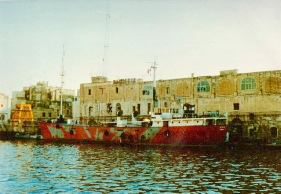© 2014-




Click on picture to enlarge
Final broadcast from the El Fatah (Mebo II)

History
Key Dates
Ship and Location
Technical
Staff




Mebo off Libya - History (2)
After arriving off Benghazi test transmissions were resumed on all three wavebands, but after two days engineers were instructed to turn off the medium and shortwave outlets, leaving only FM to carry the five hours of nightly broadcasts. After about ten days the Mebo II and the Angela entered Benghazi Harbour and engineers were told to keep the medium and shortwave transmitters silent until arrangements had been made for Libyan frequencies to be allocated to them.
Despite this instruction a number of relays of the FM test transmissions were broadcast on shortwave in December 1977 and early January 1988, announced simply as "a programme of international music."
On 15th January 1978 the, by now regular, programme did not start as usual at 7.00pm local time and announcements broadcast later in the evening indicated that the Mebo II was actually sailing away from Benghazi Harbour. The radio ship eventually arrived off Tripoli once again on 19th January and broadcasts, consisting of a relay of the Socialist People's Libyan Arab Jamahiriyah Broadcasting Corporation (SPLAJBC) in English, were made until 8.30pm local time. These programmes consisted of news bulletins, music and talks about international affairs.
On some occasions once the domestic relay had finished western pop music was played until another relay, this time in Arabic, commenced later in the evening. Broadcasts settled into a regular pattern of relays of the land-
On 5th April 1978 the Mebo II and the Angela became the official property of the Libyan Government and were re-
Whilst in dry dock both vessels were manned by between six and twelve armed guards from the Libyan Navy at all times. A Libyan Navy spokesman was reported as saying that when they had finished with the ships it was planned to take them out into the Mediterranean and sink them to prevent anybody else using the radio transmitting facilities. The vessels were not to be sold again because the Libyans did not want them to fall into the hands of any "undesirable people", probably a reference to the Israelis.
A foreign language service of the Libyan Broadcasting service SPLAJBC started from El Fatah on 11th June 1978. Each day six Arab announcers, three French speaking and three English speaking, travelled out to the ship in Tripoli Harbour to present live programmes. The announcers relied on radio engineers Robin Adcroft and 'Printz Holman' to operate the technical equipment for them and they were the only two Europeans allowed on board the radio ship -
This broadcasting arrangement lasted only until the end of June 1978 when plans were announced for a new daily service, consisting of readings from the Holy Koran between 6.00am and 6.00pm (GMT), to be broadcast using the 10 kW ex Radio Veronica medium wave transmitter as well as on 6206kHz shortwave.
On 14th August 1978 Robin Adcroft and 'Printz Holman' decided to make a clandestine broadcast on shortwave to commemorate the eleventh anniversary of the introduction of the British Marine etc. Broadcasting (Offences) Act. This transmission took place between 5.00am and 6.00am (GMT) before the broadcasts of Holy Koran readings started and were the last English language programmes ever made from the former Mebo II.
Meanwhile between 23rd June and late August 1978 the Almasira was reportedly in Valetta Harbour Malta painted in the colours of the ‘Libyan General National Maritime Transport Company’. The vessel was seen off Tripoli again on 23rd August 1978.
With the two ships becoming classified military establishments very little information is available about their use after September 1978 when the two remaining European radio engineers had been replaced by Libyan technicians.
Reception reports were received of Holy Koran transmissions being made on shortwave in late August and early September 1978, but the British Embassy reported that these broadcasts from El Fatah stopped at the end of September. However, various DX reports in Medium Wave Circle Magazine and the World Radio and TV Handbook in December 1978, January and April 1979 indicate that transmissions were still being made from the El Fatah in Tripoli on shortwave and FM.
In early March 1979 The British Embassy reported that El Fatah was still in Tripoli, flying the Libyan flag, but without any identifying name painted on her.
It is known that the El F atah was dry docked in Malta during June 1979 being overhauled and re-
atah was dry docked in Malta during June 1979 being overhauled and re-
By July 1980 the El Fatah had been moved to a position west of Tripoli at Zwara and was broadcasting on 1233kHz using the 100kW RCA transmitter still on board from RNI days. This may have been the last time the ship was used as a broadcasting base as in the autumn of 1980 Robin Adcroft returned to Tripoli to oversee the removal of the radio equipment which was put into storage on land.
There were a number of reports of sightings of the El Fatah after that date. She was reported variously to have run aground on rocks off Malta and also been sighted in Portugal during 1981 and 1982 in connection with a possible use by a breakaway group from the Radio Caroline organisation anxious to return that station to the air.
However, it is thought that sometime in 1984 (as predicted by the Libyan authorities some years earlier) El Fatah was towed into the Mediterranean and sunk as the result of being used as target practice by the Libyan Air Force. It is believed that the former Mebo (Angela) also suffered the same fate.
El Fatah (former Mebo II) in Grand Harbour, Valetta, Malta, June 1979

Thanks to the late Robin Adcroft who provided additional information about the Mebo II’s time off Libya

Back to Mebo off Libya


Back to Rest of the World Gallery
